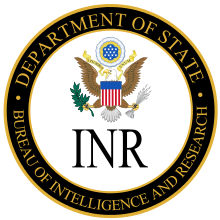Bureau of Intelligence and Research

Seal of the United States Department of State, Bureau of Intelligence and Research
|
|
| Bureau overview | |
|---|---|
| Formed | October 1, 1945 |
| Preceding agencies |
|
| Jurisdiction | Executive branch of the United States |
| Employees | 313 |
| Annual budget | $59M USD |
| Bureau executive |
|
| Parent department | Department of State |
| Website | www |
The Bureau of Intelligence and Research (INR) is an intelligence bureau in the United States Department of State tasked with providing all-source intelligence support to U.S. diplomats and analyzing information. It was founded as the Research and Analysis Branch of the Office of Strategic Services in 1942, and was transferred to the Department of State in 1945 at the end of World War II. The Bureau of Intelligence and Research is part of the U.S. Intelligence Community. The current number of employees and its budget are classified. The bureau is headed by the Assistant Secretary of State for Intelligence and Research, Daniel B. Smith.
In July 2004, the United States Senate Select Committee on Intelligence issued a scathing report on prewar intelligence on Iraq. INR was spared the poor performance review that most other intelligence agencies received, and the panel specifically endorsed the dissent that INR inserted into the National Intelligence Estimate of 2002. The bureau is being studied as a positive example, as Congress debates how to best reform U.S. intelligence agencies in the wake of the 2003 invasion of Iraq.
In May 2004, the National Security Archive released a highly classified review of INR's written analysis of the Vietnam War during the 1960s commissioned in 1969 by Thomas L. Hughes, then Director of INR. The review showed that INR had repeatedly warned of the weaknesses of the South Vietnamese Government and of the failing US strategy in Vietnam, and that, despite pressure from the military and Pentagon, INR had portrayed and projected the course of the war more accurately than any other source.
...
Wikipedia
